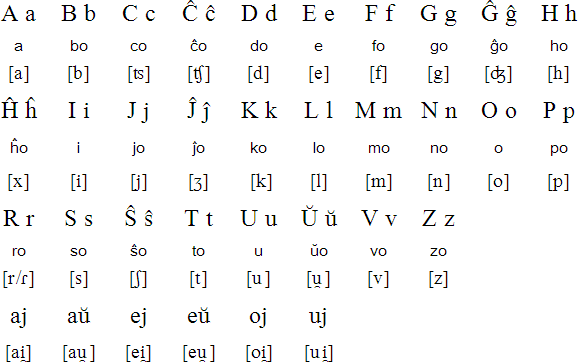Ok, so Esperanto was the first "real" language I used to communicate with people from other countries. I still use it somewhat but, I must admit, I am a bit rusty now. So, here I want to give you the basics of Esperanto so you will understand why I chose to learn this wonderful language. Lets start with the alphabet.
One of these grammatical endings should appear on the end of most
words, and defines that words role in a sentence. Other suffixes
and prefixes may precede this final identifier.
-o noun amo "love"
-a adjective ama "loving"
-e adverb ame "lovingly"
-n direct object of a verb amon "love"
-j plural amoj "loves" "j" pronounced "y"/"ee"
-jn plural of the direct object amojn "loves"
-i verb, infinitive ami "to love"
-u verb, imperative amu "love!"
-is verb, past tense amis "loved"
-as verb, present tense amas "loves"
-os verb, future tense amos "will love"
-us verb, conditional amus "would love"
As you can see, it is very easy to know what is a verb, adjective, adverb etc and the tenses are very regular and easy as well.
A complete list of pronouns. As in English, the plural "you" is
identical to the singular and does not take the plural suffix.
Possesives take the adjectival form by adding the -a suffix.
mi I
vi you
li he
ŝi she
ĝi it
ni we
ili they
oni one
ci thou (archaic)
si reflexive - refers back to subject
ri* he or she (genderless, neoligism)
*This form is very seldom every used, I have never used nor seen this form in regular communication.
Numbers follow a consistent pattern, best illustrated by example.
nulo zero dek unu eleven
unu one dek du twelve
du two dek tri thirteen
tri three dudek tri twenty three
kvar four kvindek ok fifty eight
kvin five cent sesdek a hundred and sixty
ses six sepcent okdek seven hundred and eighty
sep seven dekmiliono ten million
ok eight
naŭ nine
dek ten
cent hundred
mil thousand
miliono million
miliardo billion (thousand million)
Below is a sample of Esperanto with the Tower of Babel text:
- Sur la tuta tero estis unu lingvo kaj unu parolmaniero.
- Kaj kiam ili ekiris de la oriento, ili trovis valon en la lando Ŝinar kaj tie ekloĝis.
- Kaj ili diris unu al alia: Venu, ni faru brikojn kaj ni brulpretigu ilin per fajro. Kaj la brikoj fariĝis por ili ŝtonoj, kaj la bitumo fariĝis por ili kalko.
- Kaj ili diris: Venu, ni konstruu al ni urbon, kaj turon, kies supro atingos la ĉielon, kaj ni akiru al ni gloron, antaŭ ol ni disiĝos sur la supraĵo de la tuta tero.
- Kaj la Eternulo malleviĝis, por vidi la urbon kaj la turon, kiujn konstruis la homidoj.
- Kaj la Eternulo diris: Jen estas unu popolo, kaj unu lingvon ili ĉiuj havas; kaj jen, kion ili komencis fari, kaj ili ne estos malhelpataj en ĉio, kion ili decidis fari.
- Ni malleviĝu do, kaj Ni konfuzu tie ilian lingvon, por ke unu ne komprenu la parolon de alia.
- Kaj la Eternulo disigis ilin de tie sur la supraĵon de la tuta tero, kaj ili ĉesis konstrui la urbon.
- Tial oni donis al ĝi la nomon Babel, ĉar tie la Eternulo konfuzis la lingvon de la tuta tero kaj de tie la Eternulo disigis ilin sur la supraĵon de la tuta tero.
Well, that gives you a brief overview of the Esperanto Language. If I have piqued your interest and you would like to learn more about this language visit Lernu!

No comments:
Post a Comment